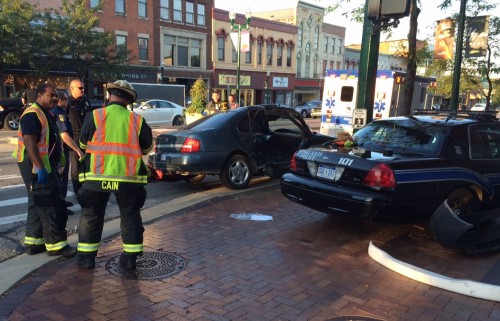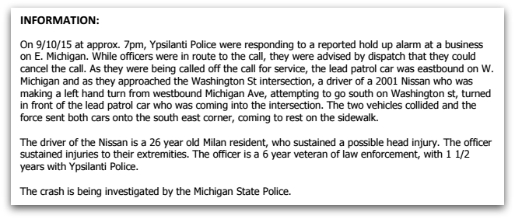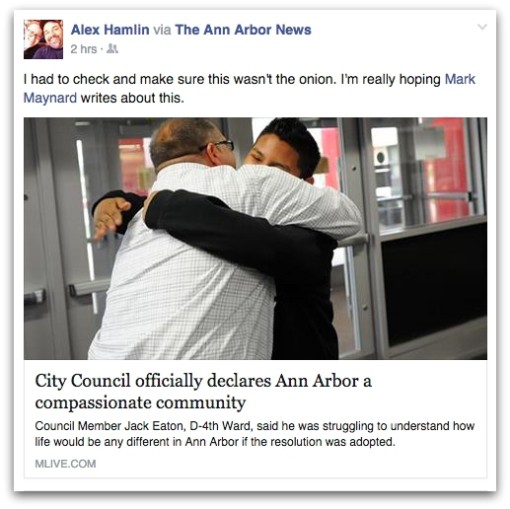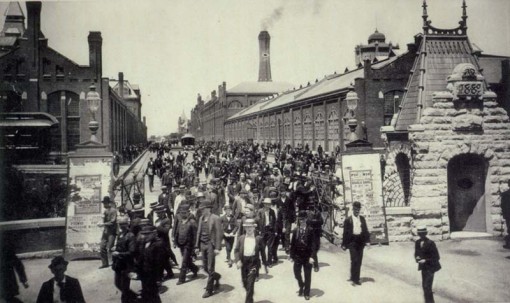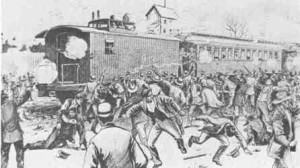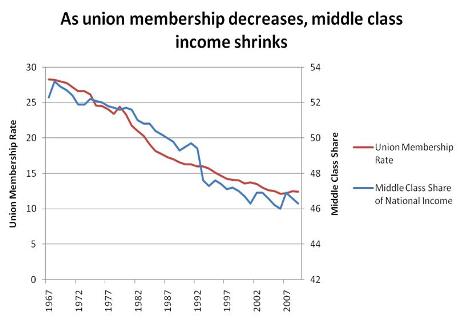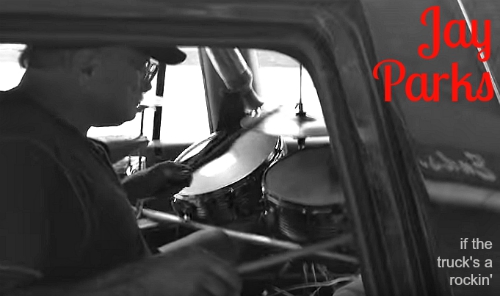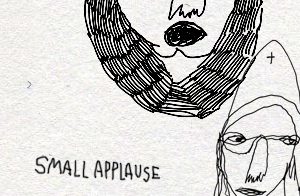Earlier this summer, the trustees of the Ann Arbor Awesome Foundation awarded a $1,000 grant to journalist-tuned-local civics champion Mary Morgan for the purposes of creating a how-to kit for those interested in hosting nonpartisan pre-election potlucks. Here, with more on this specific initiative, as well as on the newly formed CivCity non-profit from which it sprang, is my interview with Mary Morgan.
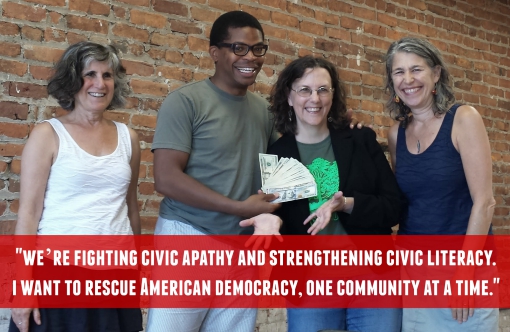
[CivCity founder Mary Morgan (second from right) with Ann Arbor Awesome Foundation trustees Sandra Gergerman, Omari Rush and Johanna Epstein.]
MARK: Let’s start by talking about CivCity. Can you walk us through your decision to close down the Ann Arbor Chronicle and launch a local non-profit dedicated to better informing the local electorate, increasing civic engagement, etc.?
MARY: We closed The Chronicle in large part because we were exhausted. We ran the publication for six years full-tilt, and while we made a modest living – I guess I’d say meager more than modest – we never were able to raise enough revenues to hire staff that would offset our work in a meaningful way. We talked about what we could do to substantially increase revenues, but realized that if we implemented those kinds of changes, it wouldn’t be the kind of publication we’d be proud of. So we decided to shut down while we were still doing our best work, six years to the date after we launched.
Our work at The Chronicle, which focused on covering local government, made it abundantly clear that most residents aren’t informed about how their local government works, and aren’t in a position to participate in the process in an informed way – or aren’t interested in doing so. It’s shocking how many people can’t tell you who represents them on city council or the county board of commissioners, but they’ll be really conversant on national issues. I’ve always been baffled by that, since it’s far easier to influence what happens locally than it is to make changes at the state or national level. Anyway, as we thought about what to do post-Chronicle, we started wondering what it would take to flip that dynamic in this community – to create a culture in which people are more informed and engaged about local issues than they are about what’s happening on the national stage. In a way it’s selfish, because I’d like to have more conversations about the local community with a broader cross-section of people – beyond just general bitching about development or what new restaurant is opening.
I also believe we need to do something to change the toxic, polarized rhetoric we see nationally, and I think the best way to do that is to start in the community where we live. So we’re using Ann Arbor as a proof of concept, with the hope that we’ll be able to develop a strategy that can be used in other communities nationwide. Basically we’re fighting civic apathy and strengthening civic literacy. I want to rescue American democracy, one community at a time.
MARK: I’m curious as to whether or not you’ve identified other civics-based non-profits around the country. And, if so, what you’ve learned from them.
MARY: A lot of organizations nationwide – companies and nonprofits, as well as educational institutions – are doing civics-related work. One example is iCivics, a nonprofit founded by former U.S. Supreme Court justice Sandra Day O’Connor. They develop and deploy online games geared toward teaching kids about various civic roles, like being a juror or how to make positive changes in your community. And some communities offer programs like a Citizens Academy, which we’d like to develop for Ann Arbor too, eventually. I’m always on the prowl for ideas we can steal. In Portland, Oregon, they hold Candidates Gone Wild forums around election time. It’s a crazy talent show – one candidate built a picture frame on stage in two minutes. Another read poetry dressed as a beatnik. And my favorite was a guy who made a smoothie with locally-sourced ingredients, which was mixed using a bike-powered blender. The event is meant to draw attention to the local election and candidates, in a creative way. Closer to home, the University of Michigan School of Information is doing interesting work through their Citizen Interaction Design unit, and I’m eager to tap their big brains for CivCity projects.
So there’s a lot going on. But what I haven’t found anywhere else is an organization that takes responsibility for trying to shift the culture of a community in a comprehensive way, with a variety of approaches. We talk about a saturation strategy, and I mean that quite literally. I want people to encounter signs of local civics wherever they go, every day – at coffee shops, bars, schools, their work, places of worship, grocery stores, sporting venues, movie theaters, fitness centers, community centers – everywhere. Banners in the streets! Stenciled chalk messages! Skywriting! Ok, maybe not skywriting. It’s also important to note that elections will be one focus, but not the only focus. We aim to raise the level of local civic literacy year-round, creating a new normal for our community – and hopefully a model for other communities nationwide.
MARK: Assuming you’ve already talked with folks at City Hall about your plans, I’m curious as to what kind of reception you’ve gotten. Are our elected officials offering to assist you, either financially or otherwise? Have they offered you poles downtown for your banners? Have they offered to participate in events?
MARY: My discussions with the city have primarily been with staff, not elected officials. I’ve talked to city administrator Steve Powers about CivCity and he was supportive – he pointed out that civic engagement is one of the staff priorities. But now he’ll likely be leaving soon to take a job in Salem, Oregon. I’ve also had discussions with Wendy Rampson, the planning manager who recently retired, and Matt Naud, the city’s environmental coordinator, and a few others. As an aside, there’s a lot of leadership turnover at the city and county, which will be either really scary or an opportunity. Still too early to tell, but it’s something to watch.
With regard to electeds, I’ve talked with several city councilmembers, county commissioners, library trustees and school board trustees, as well as people who serve on appointed boards and commissions. We’ve also gotten a fair amount of press, so I’m pretty sure that even if I haven’t talked with them directly, elected officials are aware of CivCity. The vast majority of conversations I’ve had reflect support for CivCity’s efforts, although a couple of people have pointed out that if we’re successful at what we do, it will make their jobs (and campaigns for office) more difficult. And a few elected officials have made donations to CivCity.
We haven’t received financial support from any government entity. We haven’t asked, but we likely will seek funding when it makes sense for specific projects. I think it would be totally reasonable for the city, county, library and schools to kick in a bit to support our efforts to promote the 2016 August primary, for example – or at the very least, for the city to waive its fees to hang downtown banners. But I would never want CivCity to be dependent on government funding. That wouldn’t be healthy.
Beyond financial support, people have been willing to participate in other ways. For example, during the library’s Summer Game, we had a CivCity series of badges that players could earn by doing civic-y things, like attending or watching certain public meetings. For each meeting that was broadcast via CTN, we asked someone who served on that public body – city council, county board, park advisory commission, etc. – to read aloud the game code during the meeting, so that people who were watching could get it. There were about 20 meetings where elected or appointed officials read aloud the game code during the meeting. No one turned us down when we asked – it was great! People seemed geeked to do it.
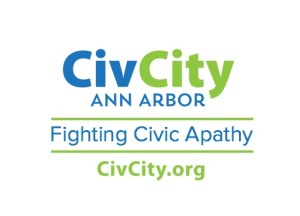 MARK: How did the idea for the potlucks come about?
MARK: How did the idea for the potlucks come about?
MARY: This was an idea that videographer Donald Harrison proposed, actually – and I loved it. He’d done this when he lived in San Francisco, and found it really helpful. After he moved to Ann Arbor, he also hosted a potluck a few years ago when the local ballot was really intense. When he described how it worked, I could instantly see the value in it.
MARK: Were you able to test the concept prior to the August 4 elections in Ann Arbor? And, if so, what did you learn from that experience?
MARY: When I applied for the Awesome grant in early May, I anticipated there would be more on the local ballot than just the city council races. But that didn’t happen. The value of the potlucks is the crowdsourcing work, especially on candidates and ballot issues that aren’t unique to a single ward. With only two candidates to research per ward, well, if someone can’t take the time to learn about two candidates on their own, that’s just pathetic. And now for the Nov. 3 election, there’s only one contested local race – Ward 2 city council, between independent incumbent Jane Lumm and Democrat Sally Petersen, who wasn’t challenged in the August primary. So we’re looking ahead to 2016, with plans to develop a toolkit for people to hold potlucks when the local ballot will be incredibly dense – council and mayoral races, county commissioners, sheriff, county clerk and prosecuting attorney, library board, school board, judicial and state races, and probably some local ballot issues too.
MARK: How will the recent grant from the Ann Arbor Awesome Foundation help?
MARY: The most obvious thing is cash flow – we’re a startup, and have been bootstrapping primarily via donations from individuals. Most of those donations are relatively small. We’re running on fumes at the moment, and every bit helps. But more broadly, getting a grant from the Ann Arbor Awesome Foundation is a stamp of legitimacy and endorsement. It helps us as we seek other funding, both from individuals and foundations. It shows that a group of community leaders believes in what we’re doing, and is willing to support us in our work.
MARK: Assuming people want to be involved… either hosting a pre-election potluck, or attending one… how would they go about doing that?
MARK: I’m collecting names of people who are interested in hosting or even in providing input as we develop a toolkit for 2016. Anyone who’s interested can email me at a2marymorgan@gmail.com. I’ll also be starting a more general e-newsletter with CivCity updates – so email me if you’d like to be added to that list too. We hope to overhaul our website sometime soon, and people will eventually be able to sign up there. Right now the site is pretty much just a placeholder. We have ambitious plans for our online presence, but of course, like everything else, it will depend on resources.
MARK: I’m curious as to how you plan to ensure that all viewpoints are considered and that these potlucks don’t just become opportunities for people who are already likeminded to come together and further reinforce their preferences. How, in other words, will you ensure that Trump supporters are included in the process?
MARY: This isn’t a trivial question. I think it’s crucial that each host feels comfortable with the format, so while we’ll be providing guidelines and a suggested approach, each potluck will have its own flavor. Some hosts might be interested in more of a debate format, with guests advocating for a particular side so that each side is represented. Others might just want to be as neutral as possible in their presentations. So there might be potlucks where everyone is more-or-less on the same page, but I would hope they’d assign people to at least play devil’s advocate. One of the things we see too often is the immediate dismissal of an opposing view – that’s especially evident at the national level, but that attitude emerges locally too. It’s easy to just say that someone’s an idiot for supporting a particular candidate or issue. But if we ask why and really try to find an answer to that question, perhaps we can find some common ground. I’d also say that for some local races – like the library board, school board and judicial races – my guess is that most people won’t have any idea who the candidates are, so the main challenge will likely be researching those candidates in order to develop an informed opinion, and there won’t be as much knee-jerk divisiveness. What can I say? At heart I’m an optimist.
MARK: Have you given much thought yet as to what the how-to kit for potluck hosts will consist of? I know you said that each event would likely take on a unique flavor of its own, but I’m wondering if there will be some points of commonality. Will there, for instance, be ground rules? And will tasks be outlined. For instance, it sounds as though it will be required that host and guests will have to perform preliminary research. Will this research follow a worksheet of some kind? Will there be modules that people can pick and choose from? Might there be some kind of game component? Might there be video tutorials?
MARY: These are all great ideas. I hope we can keep it fairly simple, but definitely include some templates the hosts can use for invitations, discussion guidelines, and resources for how to conduct research on candidates and ballot issues. Ideally, we can tailor the toolkits for each election cycle. I imagine the ground rules will be pretty basic, with an underlying directive of “Don’t be an asshole.” And of course, we’ll modify it as we get feedback from hosts and participants.
MARK: Will hosts have an opportunity, perhaps through your website, to share best practices, compare notes, post results?
MARY: That’s the plan. Our current website is really a placeholder. I have very ambitious plans for it and for our online presence in general, but it’s all dependent on resources.
MARK: What else, outside of the re-election potlucks, should we expect to see from CivCity in the short term?
MARY: We have about a dozen projects in the works, most of them in partnership with other groups. Partnerships will always be key to CivCity’s success, because it allows us to leverage resources in the community to help achieve our goals in ways we wouldn’t otherwise be able to do.
Our first real project was in partnership with the Ann Arbor District Library’s Summer Game, which ran from June through Aug. 31. We had 15 CivCity badges in the game, awarded to players a total of 1,068 times. One of my favorite badges was called Pollcat, which players earned by helping us crowdsource early election results for the Aug. 4 primary.
This summer we also partnered with Donald Harrison to do a series of short videos – called Eat This Election – that highlighted the Aug. 4 primary elections for city council. A ton of volunteers helped us with that, including some very adorable, rambunctious dogs.
We’re working with Washtenaw Literacy on a newsletter for adults who are learning to read, with the goal of reaching residents who don’t typically participate in civic life. It will feature timely, relevant local content – including information about local government. The newsletter will be used by Washtenaw Literacy tutors – and hopefully other groups as well – as they work with low-literacy adults. We hope to finish up a prototype issue this fall.
We’re partnering with the Ann Arbor Art Center to co-host a picnic on Oct. 18 as part of the POP-X festival that’s being organized by Omari Rush. People who come will discuss issues of importance to the community – while having some fun and enjoying the creativity of our city. We’ll have some special guests there as well, including sheriff Jerry Clayton, artist David Zinn, AADL director Josie Parker, Ann Arbor mayor Christopher Taylor, David Shtulman of the Jewish Federation of Greater Ann Arbor, and several others.
Also in October, CivCity is partnering with the A2 Game Designers group and GameStart School on a game jam that’s focused on local civics. That’s happening on the weekend of Oct. 23-25.
We hope to be accepted as “clients” this fall for Skyline High School’s magnet program in communication, media and public policy. Possible projects might be to develop videos featuring residents who answer the question “Why I Vote” or “Why I Don’t Vote” – and we’d look at public policy decisions that create or eliminate barriers to voting. Another possibility is to create videos featuring residents who’ve successfully undertaken civic projects – like the skatepark or the Buhr Park Food Forest – and ask them what they learned from the experience.
What else? We’re partnering with the League of Women Voters of the Ann Arbor Area to co-host a workshop in November on how to navigate local government and influence decision-makers. The workshop will be led by Joe Ohren, a political science professor who’s taught similar sessions throughout the state.
We’re partnering with the nonprofit A2Ethics to develop workshops on participatory budgeting next spring, to introduce this concept to the community and explore whether there’s sufficient interest to pursue a pilot project. I view PB as a gateway drug to learning about municipal finance, and I’m hoping we can get some buy-in to at least try it on a small scale.
In terms of an online presence, for the past few months our Twitter feed @A2CivCity has been providing daily alerts about public meetings taking place each day, including agenda highlights & other relevant information.
I know I’m missing a few things, but that should give you an idea. We’re totally under-resourced, so all of this is happening with just one full-time employee – that would be me. Dave Askins is working for CivCity on an extremely limited basis, because we can’t afford to pay him much at this point. He managed the CivCity badges for the library’s Summer Game, and has been working to strengthen the content of LocalWiki, with an eye toward eventually using that as a platform for covering local government in a comprehensive way.
Developing a news & information arm for CivCity is a longer-term and very resource-intensive project, but one that’s crucial to all of our other goals. And, of course, it’s an effort that draws on our background in journalism and experience with The Chronicle. Since we shut down a year ago, I’m a lot more uninformed about what’s happening in our community, and I’d love to figure out a way to rectify that.
[The Ann Arbor Awesome Foundation awards $1,000 cash grants each month to people with awesome ideas in the Ann Arbor – Ypsilanti area. If you have an awesome idea, apply today. This month’s deadline is September 15.]

